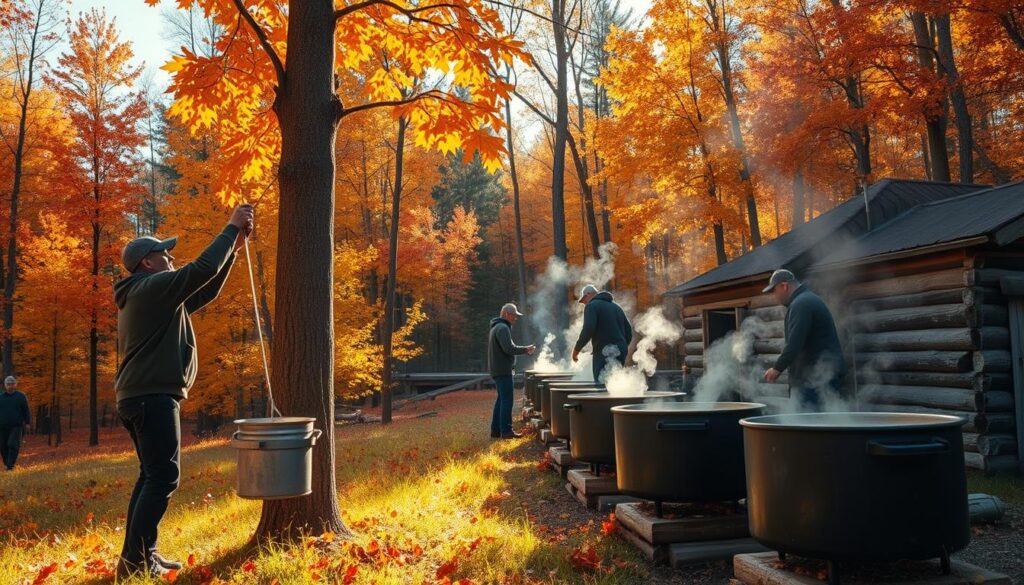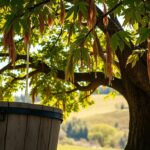Explore the world of maple sugaring, where sap turns into golden syrup. This journey links nature with cooking traditions. It’s not just about changing sap to syrup; it’s a complex process that needs skill and patience.
In places like Vermont and Quebec, experts extract maple sap. This clear liquid comes from maple trees under certain conditions. It has only 2-3% sugar, unlike the syrup we use on pancakes.
The magic begins when sap is boiled down. It takes about 40 gallons of sap to make one gallon of syrup. This shows the hard work and dedication in making maple syrup.
Maple trees, like sugar maples, are key for this syrup. They allow sap collection during specific times. This usually happens in late winter to early spring, when it’s cold at night and warm during the day.
Knowing the difference between sap and syrup helps us appreciate a beloved tradition. From ancient Native American methods to today’s commercial ways, maple sugaring fascinates many.
Introduction to Maple Tree Products
Maple tree products blend natural heritage with culinary tradition in North America. The journey of maple sap from tree to table spans centuries. It shows cultural innovation and ecological understanding.
Maple tree tapping has deep roots in indigenous North American cultures. Native American communities first discovered how to extract sweet sap from maple trees. They developed advanced Sap Collection Techniques that are the base of modern maple syrup production.
Historical Significance in North American Culture
Indigenous communities saw maple trees as sacred resources. They understood their value long before European settlers came. Their maple tree tapping methods were detailed and respectful, including:
- Careful tree selection
- Seasonal timing of sap collection
- Sustainable harvesting practices
- Traditional processing techniques
Traditional Harvesting Methods
Early Sap Collection Techniques used wooden spiles and buckets. Sugarmakers would cut small holes in maple trees. They inserted hand-carved wooden taps to let sap drip slowly into containers.
Modern Production Techniques
Today’s maple syrup production has changed a lot. New technologies make tapping more efficient, including:
- Vacuum-assisted sap collection systems
- Computerized monitoring of sap flow
- Precision tapping equipment
- Large-scale processing facilities
These innovations have greatly increased production efficiency. Yet, they keep the traditional craftsmanship that makes maple syrup special.
Maple Syrup vs Sap: Essential Differences
The world of maple production shows interesting differences between sap and syrup. Maple sap comes straight from trees in spring, looking clear and watery. It has very little sugar. On the other hand, maple syrup is made from sap after a lot of processing. It’s thick and golden.
- Sugar Content: Raw sap has about 2-3% sugar. But syrup has 66-67% sugar.
- Consistency: Sap is thin and clear. Syrup is thick and golden.
- Processing Time: It takes a lot of sap to make syrup. About 40 gallons of sap make one gallon of syrup.
Syrup Grading Standards are important for quality. The USDA has different grades for syrup. These grades are based on color, flavor, and how much light it lets through:
| Grade | Color | Flavor Profile |
|---|---|---|
| Golden | Light | Delicate |
| Amber | Medium | Rich |
| Dark | Deep | Robust |
“Maple syrup represents nature’s most complex culinary transformation.” – Traditional Sugarmaker Wisdom
Professional sugarmakers watch every step of sap processing. They make sure the best syrup gets to people’s homes.
The Science Behind Maple Tree Sap Flow
Maple tree tapping shows us a cool natural process. It involves biology and the weather. Sap moves from the roots to our buckets, thanks to temperature, tree health, and the seasons.
To tap maple trees right, we need to know how they work. Trees change in certain weather, making their sap flow special and controlled.
Seasonal Temperature Effects
Temperature is key for sap movement. Sap flows best when it’s cold at night and warm during the day. This mix of temperatures makes the sap move.
- Nighttime temperatures below 32°F (0°C)
- Daytime temperatures above 40°F (4°C)
- Consistent freeze-thaw cycles
Tree Biology and Sap Production
In winter, maple trees store starches in their roots and trunk. When it gets warmer, these starches turn into sugar. This makes a sweet liquid that flows through the tree. This natural process is key to tapping maple trees.
| Tree Component | Role in Sap Production |
|---|---|
| Roots | Starch storage and initial sugar conversion |
| Trunk | Sap transportation channel |
| Bark | Pressure regulation during sap flow |
Optimal Collection Conditions
Getting maple sap right needs the right weather and tree health. Sugarmakers watch the temperature, tree health, and how they tap to keep forests healthy.
- Select healthy, mature maple trees
- Identify optimal tapping locations
- Use proper tapping techniques
- Monitor sap flow consistently
Knowing these science facts helps us keep maple forests healthy. It also lets us make great maple syrup. This connects old traditions with today’s green thinking.
Understanding Raw Maple Sap Composition
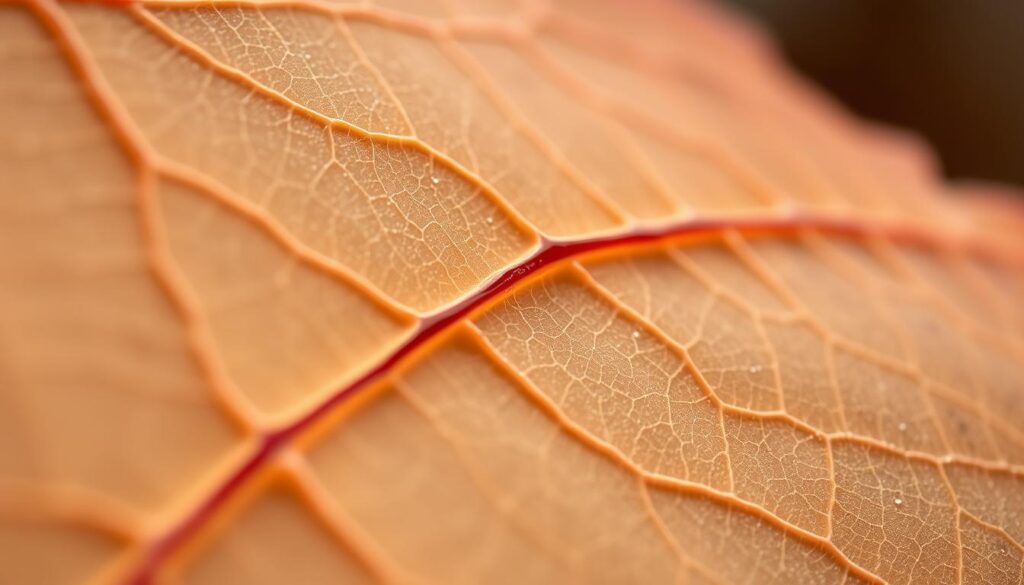
Raw maple sap is a fascinating natural liquid with complex nutritional characteristics. It contains a mix of water, sugars, and essential minerals. This makes it unique among natural plant products.
The main parts of maple sap are:
- Water (97-99.5%)
- Sucrose (2-3%)
- Trace minerals like calcium, potassium, and magnesium
- Amino acids and organic compounds
Sap collection techniques are key to keeping the sap’s nutritional profile intact. Professional sugarmakers watch the environment closely. They do this to get the sap at the best time, which affects its health benefits.
Maple sap’s mineral content offers health benefits. The trace elements in raw sap add to its nutritional value. They provide small but important amounts of essential nutrients. For example, potassium helps the heart, and calcium strengthens bones.
The purity of maple sap reflects the overall health of the maple forest ecosystem.
Different maple tree species and regional variations affect sap composition. Soil type, tree age, and local climate conditions change mineral content and sugar levels. These small differences show the complexity of this natural resource.
Scientific research is exploring maple sap’s nutritional landscape. It shows the sap’s value goes beyond being a sweet liquid. Studies on sap collection and syrup health benefits are uncovering new insights into this traditional product.
The Transformation Process: From Sap to Syrup
The Maple Sugaring Process turns raw maple sap into tasty syrup. It uses a careful and old method. Making artisanal maple syrup needs skill and knowing how to change the sap.
Sugarmakers watch every step to make sure the syrup is top quality. From the tree to your table, it’s a big change. Each step is important for the sap’s transformation.
Evaporation Methods
There are two main ways to evaporate sap:
- Traditional Wood-Fired Evaporators
- Modern Reverse Osmosis Systems
Wood-fired evaporators give syrup a smoky taste. Reverse osmosis systems remove water faster, saving time.
Sugar Concentration Stages
Artisanal maple syrup making focuses on sugar levels. The sap’s sugar is changed by heat:
- Initial sap has about 2% sugar
- Evaporation makes sugar levels reach 66-67%
- The syrup is ready at 219°F
Quality Control Measures
Quality checks are key for great maple syrup. Sugarmakers use several ways to check:
- Color grading
- Density tests
- Flavor checks
Every batch is carefully checked to ensure the syrup meets high standards.
Nutritional Comparison: Sap versus Syrup
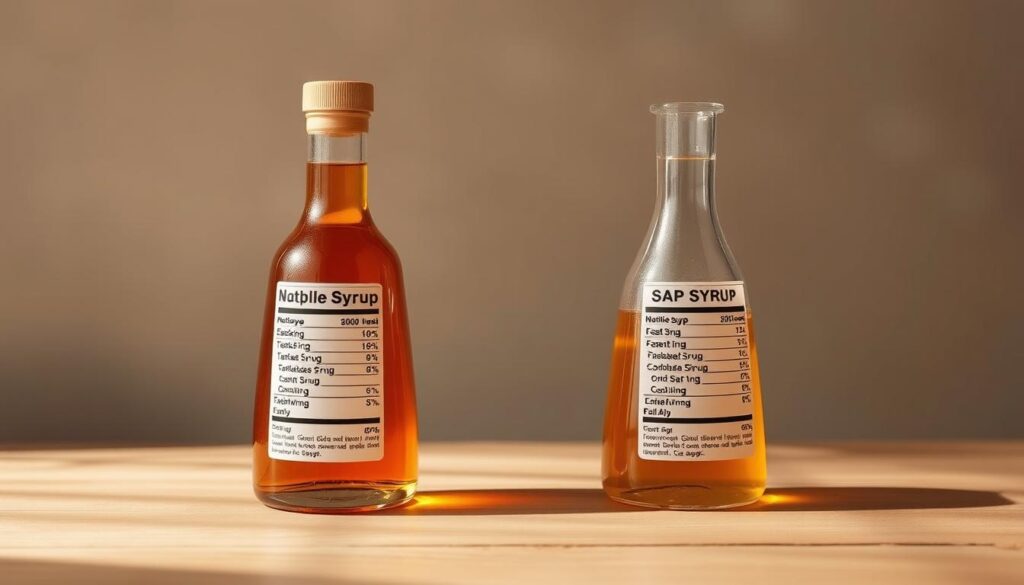
Looking at the nutritional differences between maple sap and syrup is interesting. Maple sap and syrup come from the same source but have different nutritional profiles. This is because of how they are processed.
Raw maple sap is a light drink with special nutrients. It has:
- Low sugar concentration
- High water content
- Trace minerals like calcium and potassium
- Minimal caloric value
Maple Syrup Health Benefits really show up after sap is processed. This process turns the sap into a syrup full of nutrients and antioxidants.
| Nutritional Component | Maple Sap | Maple Syrup |
|---|---|---|
| Sugar Content | 2-3% | 66-67% |
| Calories per 100g | 10-15 | 260-270 |
| Mineral Concentration | Low | High |
Comparing Maple Syrup vs Sap shows a big nutritional change. It takes about 40 gallons of sap to make one gallon of syrup. This makes the syrup much more nutritious.
The health perks of maple syrup include fighting inflammation and being rich in minerals. Zinc, manganese, and antioxidants are more in the syrup. This makes syrup a better choice than raw sap for nutrition.
Commercial Maple Syrup Production Standards
The maple syrup industry follows strict standards to ensure quality and consistency. These rules protect consumers and keep the reputation of maple syrup high.
Syrup Grading Standards are key in categorizing maple syrup. They look at color, flavor, and quality. The United States Department of Agriculture (USDA) has a detailed grading system. It helps producers and consumers understand the differences in maple syrup varieties.
USDA Grading System
The USDA has four main grades of maple syrup:
- Golden Color, Delicate Taste: Lightest grade with mild flavor
- Amber Color, Rich Taste: Slightly darker with more pronounced maple flavor
- Dark Color, Robust Taste: Stronger flavor profile
- Very Dark Color, Strong Taste: Most intense maple flavor
Quality Indicators
Producers check maple syrup in several ways:
| Parameter | Assessment Criteria |
|---|---|
| Color Density | Measured using light transmission methods |
| Sugar Content | Minimum 66% sugar concentration |
| Clarity | No sediment or cloudiness |
Industry Regulations
Maple syrup production is tightly regulated. Rules cover sanitation, processing, and labeling. These rules protect both producers and consumers in the maple syrup market.
“Quality is not an act, but a habit in maple syrup production.” – Maple Industry Expert
Sustainable Harvesting Practices
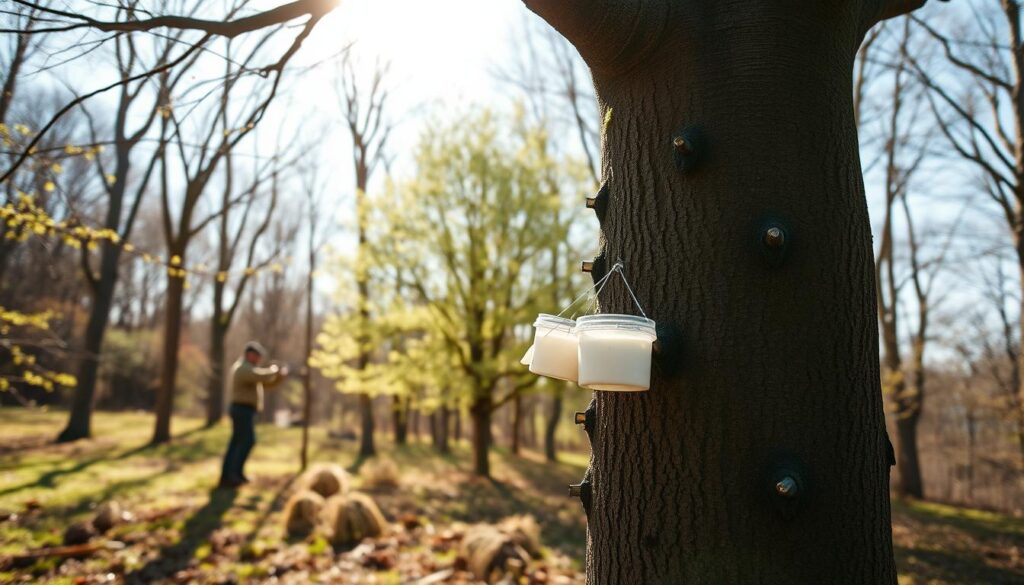
Sustainable maple forestry practices are key to keeping forests healthy while making maple syrup. Maple Tree Tapping needs careful management to protect maple forests for the future. This ensures we can keep extracting resources in a sustainable way.
Responsible sugarmakers use several important strategies to protect maple trees:
- Limiting the number of taps per tree based on trunk diameter
- Rotating tapping locations to prevent tree stress
- Using specialized equipment that minimizes tree damage
- Implementing complete forest management plans
Modern sustainable maple forestry practices focus on ecological balance and forest regeneration. Experts watch over tree health, making sure each maple tree can heal between harvests. This method stops long-term harm and keeps the forest’s natural variety.
“A healthy forest is the foundation of sustainable maple syrup production” – Vermont Maple Sugar Makers Association
Advanced sustainable techniques include:
- Genetic selection of strong maple tree varieties
- Soil conservation methods
- Ecosystem preservation strategies
- Wildlife habitat protection
By focusing on Sustainable Maple Forestry Practices, producers protect their economic interests and the environment. These methods allow future generations to enjoy high-quality maple syrup. They also help keep forests healthy and thriving.
Storage and Preservation Methods
Keeping the rich Maple Syrup Flavor Profiles right requires careful storage. Artisanal Maple Syrup Production needs special knowledge to keep the quality and taste top-notch.
First, know the special needs of maple syrup. This natural sweetener is delicate and needs the right conditions to stay fresh and flavorful.
Container Selection and Preparation
- Choose glass or food-grade plastic containers with tight lids
- Make sure containers are clean and sterilized
- Stay away from metal containers that could react with the syrup
Optimal Storage Conditions
| Storage Location | Temperature | Expected Shelf Life |
|---|---|---|
| Unopened Pantry | Cool, Dark Place | 1-2 Years |
| Refrigerated | 32-40°F | Up to 2 Years |
| Frozen | 0°F or Below | Indefinite |
Experts say to check maple syrup’s quality often to avoid crystallization or mold.
“The secret to preserving maple syrup is treating it like the liquid gold it truly is.” – Vermont Maple Syrup Expert
Shelf Life Considerations
- Look for spoilage before each use
- Keep opened syrup in the fridge
- Remove mold on the surface right away
- Always use clean tools when handling
Learning these storage tips helps keep your Artisanal Maple Syrup Production at its best. This way, you can enjoy its amazing Maple Syrup Flavor Profiles for a long time.
Culinary Applications and Uses
Maple syrup is more than just a breakfast sweetener. It opens up a world of flavors in cooking. Chefs and home cooks love its versatility, using it in many different recipes.
Knowing the difference between Maple Syrup and Sap is key. Sap is light and sweet, while syrup is richer and more intense.
- Baking: Use maple syrup as a natural sweetener in cakes, cookies, and bread
- Savory Dishes: Glaze meats, create marinades, and enhance roasted vegetables
- Beverages: Craft cocktails, smoothies, and specialty coffee drinks
- Dessert Innovations: Create unique ice creams, sorbets, and confections
Maple Syrup Flavor Profiles vary by grade, giving different tastes:
| Syrup Grade | Flavor Characteristics | Culinary Best Uses |
|---|---|---|
| Golden | Delicate, mild taste | Baking, light sauces |
| Amber | Rich, balanced flavor | Marinades, glazes |
| Dark | Strong, robust taste | Robust cooking, barbecue sauces |
“Maple syrup is not just a condiment, it’s a culinary adventure waiting to be explored.” – Artisan Chef
Professional chefs say to try maple syrup’s different flavors. Each grade has its own special taste. The journey from sap to syrup is full of flavor possibilities.
Economic Impact of Maple Production
The maple syrup industry is a key part of North American agriculture. It has a big impact worldwide. Places like Vermont, Quebec, and Ontario see it as a major economic boost.
By focusing on sustainable forestry, the industry has grown. This has opened up new chances for local makers and buyers around the world.
Market Trends in Maple Production
Recent studies show the maple product market is on the rise:
- More people want natural sweeteners.
- There’s a big demand for high-quality maple syrup.
- The market for special maple products is getting bigger.
Industry Statistics
| Year | Production Volume (Gallons) | Market Value |
|---|---|---|
| 2020 | 4.2 million | $541 million |
| 2021 | 4.5 million | $603 million |
| 2022 | 4.8 million | $678 million |
Global Trade Impact
The maple syrup industry goes far beyond local areas. Sustainable maple forestry practices make North American producers leaders. They sell to Europe, Asia, and more.
- Canada leads in maple syrup exports.
- The United States also plays a big role.
- Global demand keeps growing.
Environmental Factors Affecting Production
The Maple Sugaring Process is facing big challenges from environmental changes. Climate shifts are affecting maple tree health and sap production. This creates big problems for sugarmakers in North American forests.
Important environmental factors affecting maple syrup production include:
- Temperature changes during winter and early spring
- More unpredictable freeze-thaw cycles
- Longer warming periods that disrupt traditional sap collection times
Sustainable Maple Forestry Practices are becoming key to tackle these challenges. Researchers and forest managers are working on new ways to keep maple forest ecosystems healthy.
Important adaptation strategies include:
- Using advanced climate monitoring systems
- Choosing climate-resilient maple tree varieties
- Creating precise tapping techniques
Regional differences are important in understanding environmental impacts. Northern maple forests face different challenges than southern ones. This means they need their own sustainable management plans.
Climate adaptation is no longer optional but essential for the future of maple syrup production.
Combining scientific research with traditional forest management offers hope. It can help keep maple sugar production going in changing environments.
Conclusion
Maple syrup production is a world where nature meets human skill. It’s not just about making a sweetener; it’s a journey. Sugarmakers work hard to turn raw sap into the golden syrup we love.
Maple syrup is more than sweet; it’s good for you too. It has antioxidants and minerals, unlike regular sugar. This natural sweetener is a healthier choice for our food.
Knowing how maple syrup is made helps us value it more. It’s not just for sweetening; it’s a tradition that connects us to nature. The effort put into making maple syrup is a celebration of North America’s forests.
Exploring maple products teaches us to appreciate the balance between nature and human effort. The story of maple syrup is one of patience, skill, and the magic of a tree’s life.

